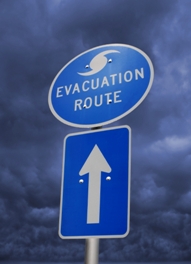Decision
The decision to evacuate should not be taken lightly, careful evaluation should be given to staying at home. Leaving your possessions, familiar surroundings, and the fear of what you may return to, are all factors to be considered. If you decide that an evacuation is necessary, and time permits, your home should be preped for your absence.
- Turn off the electricity, gas, and water at the main shut-off point in your house.
- Use plastic sheeting and a staple gun to protect belongings and help seal windows and doors.
- Open the doors of your refridgerator and freezer. This will prevent them from floating through your house and causing damage.
- Stacking furniture and electronic devices on top of a table, may help to minimise water damage. If you have a second floor, moving furniture and other valuables up to it may also help protect them during a flood event.
Preparing in advance of an evacuation will reduce time, confusion, and stress that are common in disaster situations. Having pre-made emergency kits or "BOB"(bug-out bag) should be a vital part of your preparations. These are portable kits stocked with the necessary equipment and provisions to assist you in your efforts during the initial stages of any emergency.
Along with a "BOB" you should have a personal documents packet prepared to asist you during the evacuation and your home.
Where to go?
The authorities will make shelters available at National Guard Armory's, schools, and similar facilities. While an option, these types of sites can present a new set of problems. Among them are the quality of your stay, and most importantly the safety of you and your family. There is also the option of heading for a hotel/motel outside of your area, though such a plan could become cost prohibitive depending on the duration of your relocation. If you are here in the Canebrake, you probably will not be among those to utilize such options.
So you have decided to find your safety elsewhere, now what. One option would be to set up a network, or alliance with family and friends located outside your region. There are many advantages to such an arrangement, including:
- Cost-effective
- Familiarity with both location, and people
- Ability to pre-position supplies
- "No-Vacancy" signs will not be an issue
- ...
Another option could be a safe house or refuge these could be a second property that also serves as a weekend getaway or seasonal residence.
Whether you choose to establish an alliance or utilize a retreat, either option should be located far enough away as not to be effected by any single event you might face.
How to get there?
The logical choice is an automobile, preferably a large four-wheel drive vehicle. These type vehicles meet many of the requirements you might encounter during an evacuation. They provide convenience of scheduling, are relatively fast and allows us to carry additional provisions. Four-wheel vehicles provide an excellent choice for driving during inclement weather. Because of there size these type vehicles offer better protection in accidents, have greater ground clearance, the ability to ford higher waterways and other hazards you may encounter during the evacuation. While four-wheel vehicles offer many advantages, one they do not have is fuel economy. Because of this you may want to consider having some spare fuel cans mounted on the rear for ease of access.


